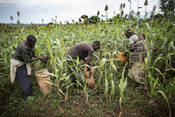26/11/2015
Workshop to implement IES in Rulindo, Rwanda

Matching opportunities for cross-sectoral collaboration
Building on the outcomes of former projects, such as Kagera TAMP, the Sustainable Food and Agriculture (SFA) approach and the Forest and Landscape Restoration (FLR) mechanism, have been developing synergies to restore and sustainably enhance the productivity of landscapes in Rwanda. These were developed in response to recommendations form the June 2015 SFA/FLR workshop held in Kigali.
The IES approach was suited to illustrate the possibilities for this coordinated approach. A two-day workshop was held 25-26 November 2015 with district-level actors in Rulindo and policy-makers in Kigali. Discussions with multiple stakeholders in Rulindo - including district government, public programmes, development partners, farmer associations and the private sector - identified and mapped existing mechanisms and initiatives that support farmers realize the benefits of producing more environmental services.
Recommendations from Rulindo to enable greater coordination of these public and private investments to upscale land restoration and sustainable production to increase food security were presented the following day in Kigali to identify and develop policy recommendations to implement this approach.
Recommendations

- Advocate for integrated approaches by developing Rulindo as a model district to illustrate that integration of agriculture and natural resource sectors can work on the ground
- Enhance district planning and coordination through a review of the Rulindo District Development Plan (DDP), including:
- Mapping of threats to ecosystem services
- Mapping of current public programme and private sector activities and incentives
- Consolidating master plans for agriculture and environment sectors
- Identify gaps and potential synergies between existing programmes to support farmers overcome adoption barriers to address ecosystem services threats
- Include in revisions, strengthening of tools for monitoring and evaluation, aligned with the SDGs
- Develop greater links between district and central level, including:
- Inclusion of district representation in central Working Groups/ Task Force
- Identify and develop opportunities for private sector investment into the landscape to support this integrated approach
- Develop extension services to include into the Farmer Field School (FFS) curricula this integrated landscape approach
Next steps for IES in Rulindo
- Support SFA/FLR to establish a baseline and gap assessment, including:
- Ecosystem status - Natural resources, agricultural productivity, food security and nutrition
- Institutional mapping of key stakeholders - specific activities and location, their target actor/ objective, incentives provided to farmers
- JADF - role as a multi-stakeholder platform, recommendations to strengthen
- Market development - identify potential markets for local production, opportunities to increase market access and value chain development (cassava leaf and coffee)
- Assess development and land use priorities
- Develop a consolidated review of existing planning mechanisms, and on-going and future development programmes (e.g. DDP, land use master plans, forest management plan, CIP, etc.), including public and private stakeholders
- Review alignment across DDP for existing and planned land uses in relation to ecosystem status map and current activities, to identify potential conflicts and synergies to coordinate multiple incentives to support farmers overcome adoption barriers
